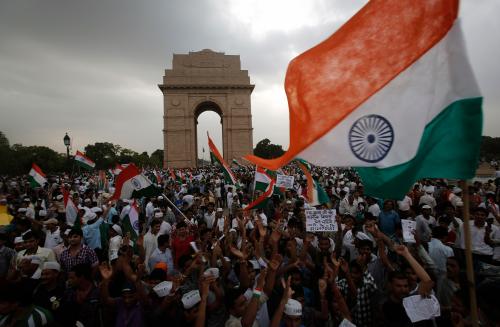Content from the Brookings Institution India Center is now archived. After seven years of an impactful partnership, as of September 11, 2020, Brookings India is now the Centre for Social and Economic Progress, an independent public policy institution based in India.
This article first appeared in the Mint.
The US and Indian navies could carry out ‘benign naval and maritime activity’ during periods of diplomatic strain.
In the ever-expanding universe of Indo-US cooperation, perhaps the brightest and most alluring star is the deepening partnership between the Indian and US navies. Consider two recent pronouncements: First, admiral Harry Harris, the commander of the Hawaii-based Pacific Command (Pacom), revealed, that both navies are engaged in “sharing…information regarding Chinese maritime movement in the Indian Ocean,” especially submarines. Second, Reliance Defence and Engineering Ltd announced that it had won a contract to service ships of the US Seventh Fleet. The latter comes in the wake of the Logistics Exchange Memorandum of Agreement (Lemoa), followed by the master ship repair agreement, between India and the US.
Both these developments underline a degree of mutual trust, confidence and growing cooperation on shore and at sea, which was previously unimaginable. But is this cooperation likely to sustain? The answer, according to a new report of the Center for Naval Analyses (CNA), a Washington research organization, is a guarded “yes.” The report is upbeat about the state of cooperation. It notes the US-India joint strategic vision for the Asia-Pacific and the Indian Ocean, Lemoa, the recognition of India as a “Major defense partner”, the joint working group on aircraft-carrier technology cooperation, and the trilateral Malabar exercise (including Japan as a permanent participant) as evidence that the relationship has “soared to new heights.”
However, it also identifies several strategic and operational factors that could limit or enhance this cooperation. Among the strategic factors are the role of China and Pakistan and Washington’s response to them; Indian party politics, particularly the return of coalition politics dependent on left parties; personalities, especially of people at the helm; and black swan events, such as a major terrorist attack on Indian soil. While none of these directly relate to the navies, they are likely to affect the overall prospects and pace of Indo-US cooperation, including naval cooperation.
Even if the strategic factors are conducive for enhancing cooperation, there are several operational factors that could stymie deeper relations. Top among them is the intransigence of the Indian bureaucracy, which “have historically reined in the military services in terms of… freedom of action”. Similarly, the lack of progress on foundation agreements, such as the Communication Interoperability and Security Memorandum Agreement and the Basic Exchange and Cooperation Agreement for satellite-based intelligence, “will affect the pace of defence engagement.”
Another operational factor where the US and India diverge is the so-called freedom of navigation operations (Fonops), which the US is particularly keen to exercise through the South China Sea. India is uncomfortable with joint Fonops for several reasons. First, it sees the Indian Ocean as its primary area of interest, not the South China Sea. Second, such cruises are bound to antagonize China, which India does not consider to be in its national interest.
Third, India is also opposed, in principle, to military ships traversing through its Exclusive Economic Zone (EEZ) and seeks prior consent for military exercises or manoeuvres in its EEZ. This position is similar to that of China and some other maritime countries. Were India to participate in the US-led Fonops, it would have to rescind on this principle and also accept the possibility of other navies—especially Chinese navy—being present in its EEZ.
Finally, the CNA report is also concerned about the “capacity constraints” on the Indian Navy, particularly the limited budget afforded to it. In particular, it worries that Indian warships “are being decommissioned faster than they are being replaced.”
The report also accurately notes India’s westward focus both overland and by sea to the Gulf region and East Africa and how this is out of the area of responsibility of the primary driver of US-India naval cooperation—Pacom. However, the report fails to note the contradictory US views on how it deals with China in the Pacific and the South China Sea and the Arabian Sea and the Gulf region. While Washington is mostly attuned towards a containment of China in the Pacific, the South China Sea and the Indian Ocean, it is leaning towards co-opting China in the Gulf and Africa. The latter is evident in Washington’s cooperation with Beijing on Afghanistan and the benign US view of the China-Pakistan Economic Corridor. In contrast, New Delhi views China’s role with concern.
Against this backdrop, the report recommends a minimalist, business-as-usual, and maximalist approach to sustaining and building the cooperation. At the very least, the US and Indian navies could carry out “benign naval and maritime activity” during periods of diplomatic strain. These could range from maritime domain awareness and information sharing to maritime peacekeeping operations and humanitarian assistance and disaster relief. In the business-as-usual scenario the two could incrementally deepen cooperation. Assuming that the strategic and operational factors remain conducive, this scenario is likely to prevail.
Were the strategic and operations factors to improve dramatically, a maximalist scenario could be envisaged. This might include US-India naval exercises and, perhaps, anti-piracy operations, with both US Central Command (responsible for the Gulf region) and the US Africa Command, in addition to Pacom. Which of these scenarios will come to fruition is dependent on the Trump administration. And that remains a black hole that even this report cannot illuminate.
The views are of the author(s).








Commentary
Op-edIndo-US naval cooperation: steady as she goes?
March 2, 2017